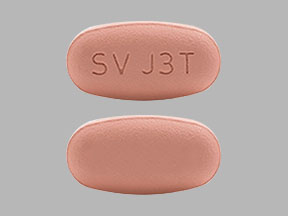Juluca and Alcohol/Food Interactions
There are 3 alcohol/food/lifestyle interactions with Juluca (dolutegravir / rilpivirine).
Multivitamins With Minerals Dolutegravir
Major Drug Interaction
Dolutegravir and multivitamin with minerals should not be taken orally at the same time. Products that contain aluminum, calcium, iron, magnesium and/or other minerals may interfere with the absorption of dolutegravir and reduce its effectiveness in treating HIV infection. You should take dolutegravir at least two hours before or six hours after the multivitamin with minerals dose. When taken with food, dolutegravir and supplements or multivitamins containing calcium or iron can be taken at the same time. Talk to your doctor if you have any questions or concerns, or if you have trouble separating the dosing times. Your doctor may be able to prescribe alternatives that do not interact. It is important to tell your doctor about all other medications you use, including vitamins and herbs. Do not stop using any medications without first talking to your doctor.
Rilpivirine Food
Moderate Food Interaction
Consumer information for this interaction is not currently available.
GENERALLY AVOID: Coadministration with grapefruit or grapefruit juice may increase the plasma concentrations of rilpivirine. The proposed mechanism is inhibition of CYP450 3A4-mediated first-pass metabolism in the gut wall induced by certain compounds present in grapefruit. In 15 study subjects given rilpivirine (150 mg once daily) with the potent CYP450 3A4 inhibitor ketoconazole (400 mg once daily), mean rilpivirine peak plasma concentration (Cmax), systemic exposure (AUC) and trough plasma concentration (Cmin) were increased by 30%, 49% and 76%, respectively. In 16 study subjects given a single 500 mg dose of a less potent CYP450 3A4 inhibitor chlorzoxazone two hours after rilpivirine (150 mg once daily), mean rilpivirine Cmax, AUC, and Cmin were increased by 17%, 25%, and 18%, respectively. Because grapefruit juice inhibits primarily intestinal rather than hepatic CYP450 3A4, the magnitude of interaction is greatest for those drugs that undergo significant presystemic metabolism by CYP450 3A4 (i.e., drugs with low oral bioavailability). In general, the effect of grapefruit juice is concentration-, dose- and preparation-dependent, and can vary widely among brands. Certain preparations of grapefruit juice (e.g., high dose, double strength) have sometimes demonstrated potent inhibition of CYP450 3A4, while other preparations (e.g., low dose, single strength) have typically demonstrated moderate inhibition. Pharmacokinetic interactions involving grapefruit juice are also subject to a high degree of interpatient variability, thus the extent to which a given patient may be affected is difficult to predict.
ADJUST DOSING INTERVAL: The administration of rilpivirine in a fasting state may decrease its oral absorption. Under fasted conditions, the systemic exposure to rilpivirine was 40% lower compared to normal or high-fat caloric meals (533 to 928 Kcal). The systemic exposure was 50% lower when rilpivirine was taken with a protein-rich nutritional beverage.
MANAGEMENT: Coadministration of grapefruit or grapefruit juice with rilpivirine should preferably be avoided. For optimal absorption, it is recommended to take rilpivirine on a regular schedule with a meal.
Dolutegravir Food
Minor Food Interaction
Information for this minor interaction is available on the professional version.
Switch to professional interaction data
Juluca drug interactions
There are 471 drug interactions with Juluca (dolutegravir / rilpivirine).
Juluca disease interactions
There are 6 disease interactions with Juluca (dolutegravir / rilpivirine) which include:
More about Juluca (dolutegravir / rilpivirine)
- Juluca consumer information
- Check interactions
- Compare alternatives
- Pricing & coupons
- Reviews (7)
- Drug images
- Side effects
- Dosage information
- During pregnancy
- FDA approval history
- Drug class: antiviral combinations
- En español
Related treatment guides
Drug Interaction Classification
| Highly clinically significant. Avoid combinations; the risk of the interaction outweighs the benefit. | |
| Moderately clinically significant. Usually avoid combinations; use it only under special circumstances. | |
| Minimally clinically significant. Minimize risk; assess risk and consider an alternative drug, take steps to circumvent the interaction risk and/or institute a monitoring plan. | |
| No interaction information available. |
Further information
Always consult your healthcare provider to ensure the information displayed on this page applies to your personal circumstances.


